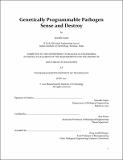| dc.contributor.advisor | Ron Weiss. | en_US |
| dc.contributor.author | Gupta, Saurabh, Ph. D. Massachusetts Institute of Technology. Dept. of Biological Engineering | en_US |
| dc.contributor.other | Massachusetts Institute of Technology. Dept. of Biological Engineering. | en_US |
| dc.date.accessioned | 2013-01-07T19:05:25Z | |
| dc.date.available | 2013-01-07T19:05:25Z | |
| dc.date.copyright | 2012 | en_US |
| dc.date.issued | 2012 | en_US |
| dc.identifier.uri | http://hdl.handle.net/1721.1/75839 | |
| dc.description | Thesis (Ph. D.)--Massachusetts Institute of Technology, Dept. of Biological Engineering, 2012. | en_US |
| dc.description | This electronic version was submitted by the student author. The certified thesis is available in the Institute Archives and Special Collections. | en_US |
| dc.description | Cataloged from student submitted PDF version of thesis. | en_US |
| dc.description | Includes bibliographical references (p. 123-134). | en_US |
| dc.description.abstract | Twenty five percent of all the deaths worldwide are caused by infectious diseases. They are also the biggest cause of mortality among children under five years of age. Among them diarrheal diseases alone cause as many deaths as AIDS or TB and malaria combined. Also up to 80% of traveler's diarrhea is bacterial in nature. Vibrio cholerae (cholera), Salmonella spp (typhoid fever), Shigella spp (shigellosis) and a variety of enteropathogenic Escherichia coli strains are among the principle bacterial agents that cause this type of diarrhea. Improvements in hygiene and access to adequate nutrition are good strategies but immunization against specific diseases still offers the best solution to fight these infections. Unfortunately the wide diversity of bacterial and viral agents that cause diarrhea complicates accurate diagnosis and makes the development of vaccines difficult. Antibiotics used in timely manner and in appropriate doses can be effective but the diagnosis is usually made too late for the therapy to be effective. Moreover frequent use of over-the-counter drugs without any medical supervision has led to multidrug resistance in most of the bacterial strains. To counter this problem I demonstrate a proof of principle of a novel cell therapy against Pseudomonas Aeruginosa (major cause of urinary tract disease and hospital infections). Using principles of Synthetic Biology I genetically modified a probiotic strain of E. coli to specifically detect PAO₁ and respond by secreting a novel, pathogen-specific engineered toxin. Additionally, I translated the bacterial system into mammalian cells and established a foundation for an adaptive system where the sentinel cells secrete an alternate toxin if the pathogen becomes resistant to the first one. Finally, based on this system I proposed designs against highly pathogenic strains of Shigella, Salmonella and Vibrio cholerae. This cell therapy remains inert until a threat is detected, and then serves as an early detection and rapid response agent. Furthermore this platform can be tuned to release minimum but sufficient amounts of very narrow spectrum antimicrobial proteins to control the early stages of infection before the disease becomes systemic. Therefore this system's rapid, automated and highly specific response can be helpful in reducing the occurrence of dose dependent resistance. This approach offers a single integrated solution to eradicating multiple threats with a strategy that is a rapid, selective, and highly sensitive. | en_US |
| dc.description.statementofresponsibility | by Saurabh Gupta. | en_US |
| dc.format.extent | 134 p. | en_US |
| dc.language.iso | eng | en_US |
| dc.publisher | Massachusetts Institute of Technology | en_US |
| dc.rights | MIT theses are protected by copyright. They may be viewed, downloaded, or printed from this source but further reproduction or distribution in any format is prohibited without written permission. | en_US |
| dc.rights.uri | http://dspace.mit.edu/handle/1721.1/7582 | en_US |
| dc.subject | Biological Engineering. | en_US |
| dc.title | Genetically programmable pathogen sense and destroy/ | en_US |
| dc.type | Thesis | en_US |
| dc.description.degree | Ph.D. | en_US |
| dc.contributor.department | Massachusetts Institute of Technology. Department of Biological Engineering | |
| dc.identifier.oclc | 820724191 | en_US |
